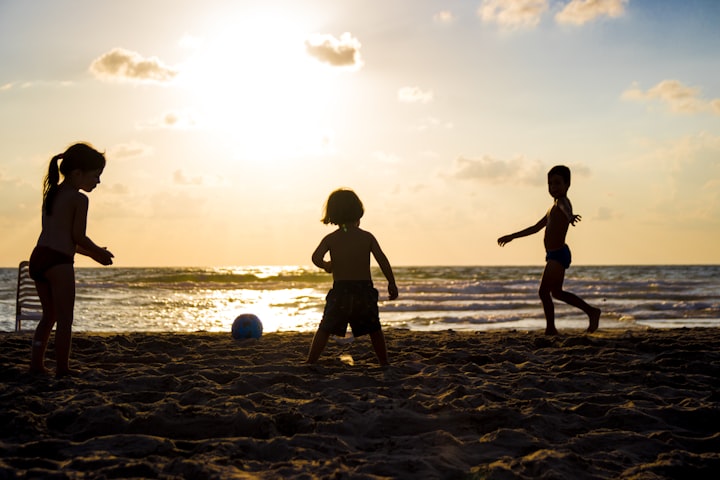Children's Sun Safety 101 - The Summer Essentials
How to protect your children from the harsh effects of the sun

As adults, we all know that too much exposure to the sun can not only be painful and irritating on your skin, but can lead to permanent skin damage, premature aging, and worse of all, skin cancer. While these may seem like intense consequences to burden a child with, as a parent, you can bear this responsibility on their behalf until they are more better able to understand such consequences.
For most children, just getting sunburnt can cause enough discomfort to create caution in their ways. Sunburns are no joke. It can also make it uncomfortable to sleep and even put on clothes until your skin heals. Then there’s the unsightly issue of having to deal with peeling skin. Children don't have to be in the sun long to experience the sun's harmful rays. Babies and children are at particular risk of sunburn and skin damage because of their delicate skin.
As a parent, you can put the appropriate measures in place to prevent sunburn and sun damage happening to your children. Remember to plan ahead and bring a bag filled with sunscreen, protective clothing, and limit your children's sun exposure.
Here's our list of the top summer essentials to help you practice sun safety.
1. Limit your sun exposure during certain times a day
Children love playing outdoors. During the summer months, you'll likely spend more time outside in nature or at the beach or pool. To avoid sunburns and sun damage, reduce your children's exposure to the sun between 10 am and 2 pm (11 am and 3 pm in daylight saving time). This is the time of day where the sun’s UV rays are its peak.
Even when it's cloudy outside, children need protection. Clouds do not block UV rays; they filter them.
UVA rays cause skin aging and wrinkling and contribute to skin cancer.
UVB rays cause sunburns, cataracts (clouding of the eye lens), and effects on the immune system, according to KidsHealth.org
2. Do your research and choose the right sunscreen for your child
When it comes to sunscreens, there are countless brands out there. Do your research and opt for one that has a high SPF. Water-resistant, broad-spectrum sunscreen with an SPF 30 or higher will be the safest choice for your kids to protect them from both UVA and UVB rays.
3. Be sun safe with a hat that protects your child's head, face, ears, and neck
Few children naturally love wearing hats. At some point in time, you’ll have the inevitable battle of wrestling one onto their little head. The best way to get your child used to wearing one, is to lead by example and acquaint them with the habit of wearing a hat from an early age. Stick to a wide brim or bucket style that protects their face, ears, and back of the neck. If you opt for a baseball cap, make sure you are using sun protection on their ears, neck, and any other areas where they can be exposed to the sun.
4. Choose clothing and swimwear with a strong UPF
If you don't want to be consistently applying sunscreen on your child to make sure they're protected, sun-safe clothing and swimwear is a great alternative. There are actually kids rashies that have built in UPF (ultraviolet protection factor) to prevent UV rays from penetrating the fabric. Using rash guards and long sleeve tops are also a great way to practice sun safety.
5. Protect your child's eyes with sunglasses
Searching for the perfect sunnies for your little one? Go beyond the stylish designs and make sure the sunglasses you choose have 100 percent UVA/UVB protection. According to the CDC, sunglasses protect your child's eyes from UV rays, which can lead to cataracts later in life.
6. Stick to cooler zones and look for shady areas for your kids to play
In the summer months, many cities designate cool zones for children and families to use, so you don't have to spend all day trapped inside your air-conditioned home. Venture out to these cool zones and look for parks with shady areas where your children can play. Before you let them loose, check the slides and bars to make sure they're not too hot, so your children don't burn their little hands.
7. Use sun protection every day, not just in summer
While you may be prepared during the summer months, don't let your guard down in other seasons. Sun protection should be top of mind every day.
Use something to block the sun from hitting your child's car seat.
Check to see if your child is being exposed to too much sun while in their stroller.
Be a good role model, and get in the habit of being sun safe yourself, so your child understands why they need to wear a hat and sunscreen.
8. Be proactive
It's up to you to take action to make sure you're monitoring your child's sun safety. Besides protective clothing, sunscreen and limiting sun exposure, check with your doctor to understand the facts about sun exposure. Check for moles and be proactive. Jot down questions for your doctor, so you're prepared for your next visit.
If your child's skin starts to look a little pink, this could be an early sign of sunburn. The CDC reports that it can take up to 12 hours for skin to show the full effect of sun exposure.
Children's Sun Safety 101
Nobody likes getting a sunburn; especially your children. Avoid any risks by practicing sun safety. Limit your child's sun exposure and invest in summer essentials to keep your child protected.
About the Creator
Anita White
Anita White is the passionate owner of Sandy Feet Australia; the fashionable sun safe kids swimwear brand based on the Sunshine Coast. She loves exploring the outdoors with her husband and two kids and of course, in a sun safe manner!






Comments
There are no comments for this story
Be the first to respond and start the conversation.